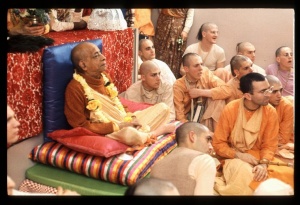CC Adi 7.4 (1975)

A.C. Bhaktivedanta Swami Prabhupada
TEXT 4
- pañca-tattva avatīrṇa caitanyera saṅge
- pañca-tattva lañā karena saṅkīrtana raṅge
SYNONYMS
pañca-tattva—these five tattvas; avatīrṇa—advented; caitanyera—with Caitanya Mahāprabhu; saṅge—in company with; pañca-tattva—the same five subjects; lañā—taking with Himself; karena—He does; saṅkīrtana—the saṅkīrtana movement; raṅge—in great pleasure.
TRANSLATION
These five tattvas incarnate with Lord Caitanya Mahāprabhu, and thus the Lord executes His saṅkīrtana movement with great pleasure.
PURPORT
In Śrīmad-Bhāgavatam there is the following statement regarding Śrī Caitanya Mahāprabhu:
- kṛṣṇa-varṇaṁ tviṣākṛṣṇaṁ
- sāṅgopāṅgāstra-pārṣadam
- yajñaiḥ saṅkīrtana-prāyair
- yajanti hi su-medhasaḥ
"In the Age of Kali, people who are endowed with sufficient intelligence will worship the Lord, who is accompanied by His associates, by performance of saṅkīrtana-yajña." (SB 11.5.32) Śrī Caitanya Mahāprabhu is always accompanied by His plenary expansion Śrī Nityānanda Prabhu, His incarnation Śrī Advaita Prabhu, His internal potency Śrī Gadādhara Prabhu and His marginal potency Śrīvāsa Prabhu. He is in the midst of them as the Supreme Personality of Godhead. One should know that Śrī Caitanya Mahāprabhu is always accompanied by these other tattvas. Therefore our obeisances to Śrī Caitanya Mahāprabhu are complete when we say śrī-kṛṣṇa-caitanya prabhu -ityānanda śrī-advaita gadādhara śrīvāsādi-gaura-bhakta-vṛnda. As preachers of the Kṛṣṇa consciousness movement, we first offer our obeisances to Śrī Caitanya Mahāprabhu by chanting this Pañca-tattva mantra; then we say Hare Kṛṣṇa, Hare Kṛṣṇa, Kṛṣṇa Kṛṣṇa, Hare Hare Hare Rāma, Hare Rāma, Rāma Rāma, Hare Hare. There are ten offenses in the chanting of the Hare Kṛṣṇa mahā-mantra, but these are not considered in the chanting of the Pañca-tattva mantra, namely, śrī-kṛṣṇa-caitanya prabhu-nityānanda śrī-advaita gadādhara śrīvāsādi-gaura-bhakta-vṛnda. Śrī Caitanya Mahāprabhu is known as mahā-vadānyāvatāra, the most magnanimous incarnation, for He does not consider the offenses of the fallen souls. Thus to derive the full benefit of the chanting of the mahā-mantra (Hare Kṛṣṇa, Hare Kṛṣṇa, Kṛṣṇa Kṛṣṇa, Hare Hare Hare Rāma, Hare Rāma, Rāma Rāma, Hare Hare), we must first take shelter of Śrī Caitanya Mahāprabhu, learn the Pañca-tattva mahā-mantra, and then chant the Hare Kṛṣṇa mahā-mantra. That will be very effective.
Taking advantage of Śrī Caitanya Mahāprabhu, many unscrupulous devotees manufacture a mahā-mantra of their own. Sometimes they sing, bhaja nitāi gaura rādhe śyāma hare kṛṣṇa hare rāma or śrī-kṛṣṇa-caitanya prabhu-nityānanda hare kṛṣṇa hare rāma śrī-rādhe govinda. Actually, however, one should chant the names of the full Pañca-tattva (śrī-kṛṣṇa-caitanya prabhu-nityānanda śrī-advaita gadādhara śrīvāsādi-gaura-bhakta-vṛnda) and then the sixteen words Hare Kṛṣṇa, Hare Kṛṣṇa, Kṛṣṇa Kṛṣṇa, Hare Hare Hare Rāma, Hare Rāma, Rāma Rāma, Hare Hare, but these unscrupulous, less intelligent men confuse the entire process. Of course, since they are also devotees they can express their feelings in that way, but the method prescribed by Śrī Caitanya Mahāprabhu's pure devotees is to chant first the full Pañca-tattva mantra and then chant the mahā-mantra-Hare Kṛṣṇa, Hare Kṛṣṇa, Kṛṣṇa Kṛṣṇa, Hare Hare Hare Rāma, Hare Rāma, Rāma Rāma, Hare Hare.